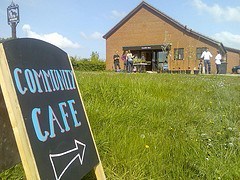Creating an Economy for the Common Good
The retail co-operative movement and its associated mutual experiments, was for a time a parallel economy for the common good to the dominant liberal economy of the Victorian era.
It challenged not only the mainstream economy but also the stream of socialism based on trade unions and centralised state ownership. It offered collective ownership as an alternative to private and state ownership.
This model not only flourished but initiated many institutions that are today foundational to the mainstream economy. Sadly, the government privatised many of these institutions; privatisation has absorbed not only nationalised industry but many mutuals. Its grip on the economy and our imagination is far greater than the so-called threat of communism achieved.
From the perspective of the twenty-first century, communism was never an alternative to capitalism. The Soviet Union practised state capitalism and trade union based socialism in Britain was an accommodation to the capitalist economy and not a genuine alternative to it. The difference between twenty-first century businesses and the days of trade union power is the decline of large industry. It is hard to see how unions could regain the power they once had without these large employers. Large companies these days are not employers but accumulate capital. Perhaps these differences are a matter of degree but trade union decline cannot be fully reversed by a more favourable legal environment.
Change Everything
It is hard to envision an alternative to the prevailing neo-liberal model and that is why I welcome Christian Felber’s new book, “Change Everything: Creating an Economy for the Common Good”. Here at last is a credible alternative!
The Economy for the Common Good is an international movement, originating in Austria. Felber’s book is the first time his thinking has been available in English. In it he describes a framework for a new understanding of the economy; moving from “the business of business is business” to “the purpose of business is the common good”.
It is important to understand Felber is not promoting a single model for the economy but a different standard any number of models can address. This standard attempts to overturn the neo-liberal mindset, which sees competition as central, to a worldview based on co-operation. I’m planning to review this book over several posts. In this first post, I shall make three comments, reflecting my concerns about his approach. They are not so much criticisms as attempts to show where there may be difficulties.
I want to promote the book as I cannot possibly, in a few posts, do justice to the ground it covers. These comments may assist a critical reading.
Co-operation happens already
One of the lies about the neo-liberal model of the economy is business depends solely on competition. Felber claims competition is less effective than co-operation and I would go even further.
Felber includes a chapter of examples of the economy for the common good from all over the world. These are valuable and important and I plan to write about some of them soon.
What I don’t think he dwells upon fully is how even neo-liberal business depends on co-operation. Competitive ideology undermines business because it is naturally collaborative. Successful businesses collaborate. Many small business owners flounder because they believe the politicians and think they are in a cutthroat competitive environment.
Too much business collaboration is behind closed doors. Many scandals are where politicians are swayed, where relationships become way too cosy.
So, with the neo-liberal worldview collaboration can become counter-productive but for most small businesses it is a natural route to a prosperous business. Good businesses put business in the way of other businesses; they help one another to grow.
Felber’s values would place business collaboration in the service of the common good and not primarily for private profit. He does not rule out private profit but moves it away from being the main point of economic activity. Many entrepreneurs might embrace Felber’s approach because it offers a more supportive environment than the neo-liberal model with its aim to centralise economic activity in a few powerful hands.
An economy within an economy?
Felber’s approach is admirable because it could in principle replace the prevalent neo-liberal model. It’s certainly possible, after all in the immediate post-war years, neo-liberalism was the preserve of eccentrics. Owen Jones describes in the first chapter of his book, “The Establishment“, how these peripheral eccentrics developed the dominant ideology of our time. Now we’re the eccentrics, up against powerful vested interests.
The reality is, for a time at least, the two worldviews will co-exist. This is much as it was for the co-operative movement. For all its successes it never broke through and ultimately lost out to the uneasy alliance between capitalism and a trade union based socialism. We can see now this version of socialism was not really an alternative to the capitalist system but an adjunct to defend the interests of workers within the system. This unstable alliance ultimately collapsed when neo-liberalism became dominant during the 1980s.
Never underestimate the power of dominant ideologies to colonise opposing worldviews, just as mutual businesses have become neo-liberal businesses. Another example is the domination of the Christian faith by the Roman Empire. Constantine bought into Christianity because he believed it would help him win wars. That ideological struggle continues to this day at the heart of every church congregation.
A Worldwide Movement for Change?
Is it really credible that a worldwide movement can usher in a new approach to the economy over the entire world? It is a tall order and I hesitate to even concede it is possible.
I think we need to look again not only at the successes of alternative economies but also at their failures. Why did the co-operative movement lose out to the conventional economy, to the extent it largely disappeared in the 1980s UK?
It’s worth asking how far we can go without dismantling the neo-liberal systems? It may be essential to dismantle them but what happens if they persist? What if the vested interests are too powerful? What can be achieved under those circumstances?
Understand I ask these questions to strengthen the movement. People need to see immediate benefits if they are to commit to this approach. Each person who commits weakens the old system and so the advantages of a parallel economy need to be clear. I shall return to this theme in the future, especially to explore how the Internet can support this parallel economy.
The Challenge to Privacy
Many people fear what happens if Felber’s models are too full on. What if our economic systems imply a society where differences are not tolerated, where everyone knows everyone else’s business?
This appears to be a concern among those living in alternative communities and it is something important to take seriously. Why?
Because the last socialist experiment was a civil liberties disaster. Granted it was state capitalism, capitalism by other means. But it is always true in human systems that freedom and equality can be opposed.
Felber’s approach is attractive because there is no single model. Small businesses can still exist, offering independence to their owners and they can choose the extent to which they adhere to Felber’s framework. This allows perhaps sufficient wriggle room to allow substantial freedom in a world where there is greater equality.
Freedom and equality are not natural givens and they need to be understood and defended. What do you think?


